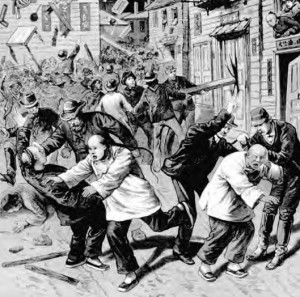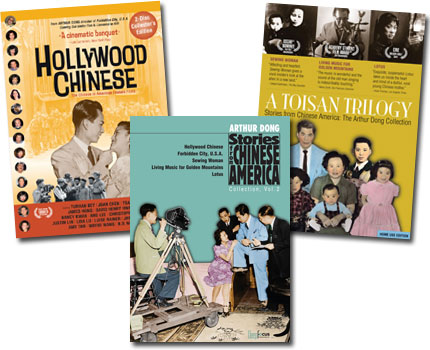It took four decades before Japanese Americans received a formal apology for the internment of 120,000 people of Japanese descent during World War II. The apology was part of the Civil Liberties Act of 1988, which was signed into law by President Ronald Reagan. The Chinese in America are still waiting for an apology from the top, 129 years after the Chinese Exclusion Act of 1882 was signed by President Chester A. Arthur.
The Chinese Exclusion Act was one of a series of laws enacted against Chinese immigrants starting in 1879 through 1904. The 1882 Exclusion Act squeezed Chinese immigration to the US to barely a trickle – and cut down rights for Chinese already in the US, for example by excluding Chinese from citizenship and therefore denying them the right to own any property. Amazingly, the act remained on the books until 1943, when it was repealed in large part because China became an ally during WWII. It remains to this day the only US legislation that singles out people by ethnicity or national origin.
On Oct. 11, with the help of organizations including the 1882 Project, JACL and OCA, the Senate passed a resolution apologizing for the Chinese Exclusion Act. Now these groups are pushing for a similar bill, House Resolution 282, to pass in the House.
Mainstream American culture goes in cycles when it comes to anti-Chinese sentiment, and we’re in one of those periods, mostly because China is ascending to its new position as one of the top world economies and that stirs up race-based xenophobia.
In the 1880s, the Chinese were accused of driving down wages by providing cheap labor and the solution was to clamp down on immigration (sound familiar?). Today, the exploding Chinese economy is combined with their undervalued currency and blamed for American job losses.
The Chinese were the first Asians to immigrate to the US in large numbers. Only a few Filipinos and a stray Japanese sailor or two preceded them, although there are historians who think Chinese settled in North America before the Europeans. But their experience is mirrored in the waves of Asian immigrant that followed: The Japanese, East Indian and Filipino. The immigrants are welcomed as manual laborers, but when they attain business success white Americans felt threatened and their rights were curtailed (or they were chased out of their mines or forced out of towns where they’d built a Chinatown district.
These cycles will continue to repeat unless we educate ourselves. There are some great sources to become more familiar with the history of Chinese immigration to the US.

Illustration of the anti-Chinese riot in Denver's "Hop Alley" Chinese district in 1880, in which one Chinese man was lynched. A historic marker now commemorates the event in the popular entertainment district that's today known as Lower Downtown, or "LoDo."
Another great source for insight into the history of Chinese in America is the boxed set of films on DVDs (also available individually) by filmmaker Arthur Dong, who explores his Chinese American identity in sharply observed, evocative documentaries and short features.
His “Stories from Chinese America Collection, Vol. 2†includes “Hollywood Chinese,†a fascinating documentary that traces Chinese in the US movie industry with revealing insights from Asian actors as well as Caucasian actors like Christopher Lee and Luise Rainer, who played Chinese characters in yellowface makeup. The disc also features a bonus film from 1916, “The Curse of Quon Gwon,†which is thought to be the first Chinese American film produced.
The second disc in the set, “Forbidden City, U.S.A.,†is a loving chronicle of a famed nightclub – Forbidden City was considered the Asian Cotton Club — in San Francisco throughout the 1930s to the ‘50s.
The third disc in Dong’s trilogy is “A Toisan Trilogy,†shorter films directed by Dong that include the 29-minute feature, “Lotus,†about a woman in early 20th century China with bound feet and the changing role of women. There’s also Dong’s affectionate look at the elderly Chinese man who teaches him to play the traditional lute, “LivingMusic for Golden Mountains,†made in 1981 while Dong was still a film student; and “Sewing Woman,†a toucbing documentary based on the experience of Dong’s mother, who immigrated to the US after WWII and worked as a seamstress for decades.
Knowing the history of China and Chinese people, and understanding its relationship to the rest of the world both a century ago and today will surely break down some barriers between our countries and people.
And hopefully, learning about the Chinese will eventually help eliminate the ignorance that spills out into China-bashing every few years when Americans feel economically threatened.
(This post is also submitted to the Pacific Citizen newspaper of the JACL.)












Hi, Gil
I really liked this post, I learned many things. Thank you. I will look for the Arthur Dong’s DVD.
Wendy
Excellent account. Americans should remember that they descended from immigrants also seeking a better life. But most of them forgot that they also drove the indigenous Americans from their lands and humiliated them to boot. Sinophobia remains very strong in the USA evenamong top leaders and businessmen who have been profitting in doing business in China. American sinophobia seems incurable for US leaders even incite countries with territorial disputes over the South China Sea to fight China. US re-arming Japan and supplying arms to Taiwan and to South Korea only provoke mutual suspicion and hatred leading to another round of arms race. We need to persuade people that we should behave in a give and take manner not arrogance and military interventions that US leaders use around the world.
Thanks for your thoughtful comment, Aurora!